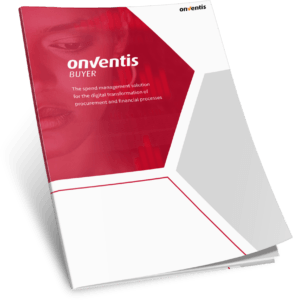Choosing The Right Procurement Software: Source-to-Pay-Suite vs. Best-of-Breed
The digitalization of procurement processes presents buyers and procurers with the challenge of selecting suitable procurement software. But amidst the multitude of available solutions, the question arises: which software can meet your company’s individual requirements?

Choosing The Right Procurement Software: Best-of-Suite vs. Best-of-Breed
The digitalization of procurement processes presents buyers and procurers with the challenge of selecting suitable procurement software. But amidst the multitude of available solutions, the question arises: which software can meet your company’s individual requirements?
Before making a decision, buyers need to get a clear understanding of the process of selecting and weighing individual solutions. The question of whether to consider individual “best-of-breed” solutions also plays an important role. This is contrasted with source-to-pay software that covers the entire procurement process. Selecting software for procurement is not easy, as various factors must be taken into account to find the optimal solution for one’s company. In this blog, we will explain the differences between the approaches and show you the advantages of the Onventis Best-of-Suite to provide you with the best possible support when selecting procurement software.
The Best-of-Breed Approach: One Solution For Individual Problem Zones
The best-of-breed principle represents the combination of different individual solutions in procurement. Companies select different software solutions that make up their IT landscape – the most suitable technology on the market is selected for each process step or task. These components can be interconnected through significant effort to form a cohesive platform, collectively encompassing the entirety of the procurement process.
Individual procurement software solutions concentrate on single subranges. Enterprises select separate providers for their sourcing, their invoice processing and their expenditure analysis. For each purpose and each area of application, a solution suite from different suppliers is integrated and combined.
Who is the best-of-breed approach suitable for? This approach is particularly recommended for companies that need a quick solution for a specific problem that is limited to a sub-process step in procurement. If, for example, there is a desire to automate and digitize invoice processing alone, a specialized solution for invoice processing can be selected. This allows companies to target their “problem areas” and drive digitization forward in individual process steps, according to their own speed and prioritization.
Best-of-Suite: An All-in-One Solution For The Entire Procurement Process
The best-of-suite approach is based on an all-in-one solution that covers the entire need. It is an end-to-end platform that guides the procurement team from sourcing to invoice processing to spend analysis.
In procurement, the focus here is on the source-to-pay concept, which covers all steps of procurement and represents an all-in-one procurement software. You have one solution for the sourcing process, supplier management, order, and payment, so that each partial process step is covered by a single provider.
In comparison to best-of-breed solutions, best-of-suite providers usually have the reputation of not possessing in-depth expert knowledge. Since they are not focused on one subarea but cover more than one process step, they are said to have only superficial know-how about the individual modules. However, this often turns out to be just a myth: in fact, they can add real value by integrating different expertise into their products and services. Most best-of-suite solutions are flexible for this purpose and can be adapted to the needs of different industries and business units. This requires a deep understanding of the requirements in these niches. However, it is important to consider the unique requirements of your business and industry and engage directly with vendors to verify their expertise and knowledge.
The Concrete Advantages Of The S2P Concept:
- Usability: In the best-of-suite approach, one comprehensive procurement software is available for the entire purchasing process, ensuring a consistent user experience. The seamless integration of all components results in a consistent user interface and experience for all users within the organization. This ensures ease of use in all cases, which drives the adoption of the software. Buyers do not have to adapt to different systems and ways of working, and therefore increase efficiency in the procurement process.
- Training effort: Opting for a source-to-pay solution instead of standalone solutions brings a significant advantage in terms of training effort during software implementation. With an S2P solution, employees only need to be trained once for the entire end-to-end procurement software, instead of conducting separate training sessions for different standalone solutions. At the same time, it ensures that all employees follow the same processes and standards, ensuring consistent implementation of corporate policies and best practices.
- Cost savings: An organization’s decision to adopt a comprehensive source-to-pay solution instead of standalone solutions enables significant cost savings. Consolidating licenses results in significant savings in license fees. At the same time, training time and costs are reduced considerably, as employees only need to be trained once for the entire procurement software instead of conducting separate training sessions for individual solutions. In addition, implementing an S2P solution typically requires less time and resources compared to implementing multiple standalone solutions. This means lower project costs and less personnel effort.
- Problem handling: When using an S2P solution, companies have a single point of contact for all aspects of their procurement process. If a problem or error occurs, buyers only need to contact one provider for support and solutions. This greatly simplifies communication and problem resolution, as there is no need to coordinate between different vendors.
- Successive build-up and scalability: The best-of-breed approach has the advantage that the IT landscape can be built up successively, as each solution can be deployed individually. However, an S2P suite also enables procurement to be digitalized step by step. Companies can add modules as needed and therefore control the implementation process to meet the requirements of a growing company. Since the various modules of the procurement software are well aligned, the phased implementation does not require extensive training. This additionally enables faster integration and usage, minimizing business disruption.
- Smooth integration: All functions within the suite are seamlessly integrated, resulting in smooth data exchange between the different phases of the procurement process. There are no system breaks or data inconsistencies as everything is integrated into a single platform. This ensures uninterrupted and unrestricted communication within the procurement team and smooth data transfer across the solution.
- Enhanced analytics through data accuracy: Best-of-suite software solutions often offer advanced analytics tools that enable companies to gain insights into their procurement data. Because the data exchange is seamless, the analytics data is correspondingly more accurate. This makes it easier to identify potential savings, optimize procurement strategies, and make better decisions.
- Ensuring compliance: A holistic procurement software helps companies comply with regulations and policies. By covering all relevant processes, companies can ensure that their procurement practices comply with applicable laws and internal policies and avoid legal and financial consequences.
Who Is The S2P Concept Right For?
For companies that want to implement digitalization throughout their entire procurement process and achieve a uniform level of digitalization, the total package approach is recommended. Especially in purchasing organizations that want to map their entire procurement digitally, best-of-suite and holistic procurement software is suitable. You get all the tools you need in one fell swoop, which are coordinated with each other and offer a consistent user experience. Companies whose teams work closely together and prefer a unified platform benefit from this.
Best-of-Breed vs. Best-of-Suite, What Now?
When selecting software for procurement, it is important that companies take a look at the future: What are the current and long-term problems or potential for my procurement activities? What costs will I incur if I opt for a partial solution today and digitalize another process step later? How high is the cost if I only tackle the automation of my procurement activities step-by-step without taking a long-term view of the future? These questions challenge purchasers to question their decisions and to think with the future in mind. In doing so, they avoid unnecessary costs and the overhead associated with implementing procurement software, whether they choose best-of-breed or best-of-suite solutions.
That said, procurement teams should be aware that inaction comes with significant risks, including loss of competitive advantage due to insufficient digitization, as well as cost and productivity losses due to manual process execution. These dangers are just a few examples of the challenges associated with non-digitized procurement processes.
No matter which approach you choose, the most important thing is not to wait and invest in software for purchasing. Every company has to decide individually which solution is the right one for its internal processes. Different requirements, budgeting, and the level of digitalization are crucial for this decision.
Weitere BlogsMore BlogsMeer blogs




